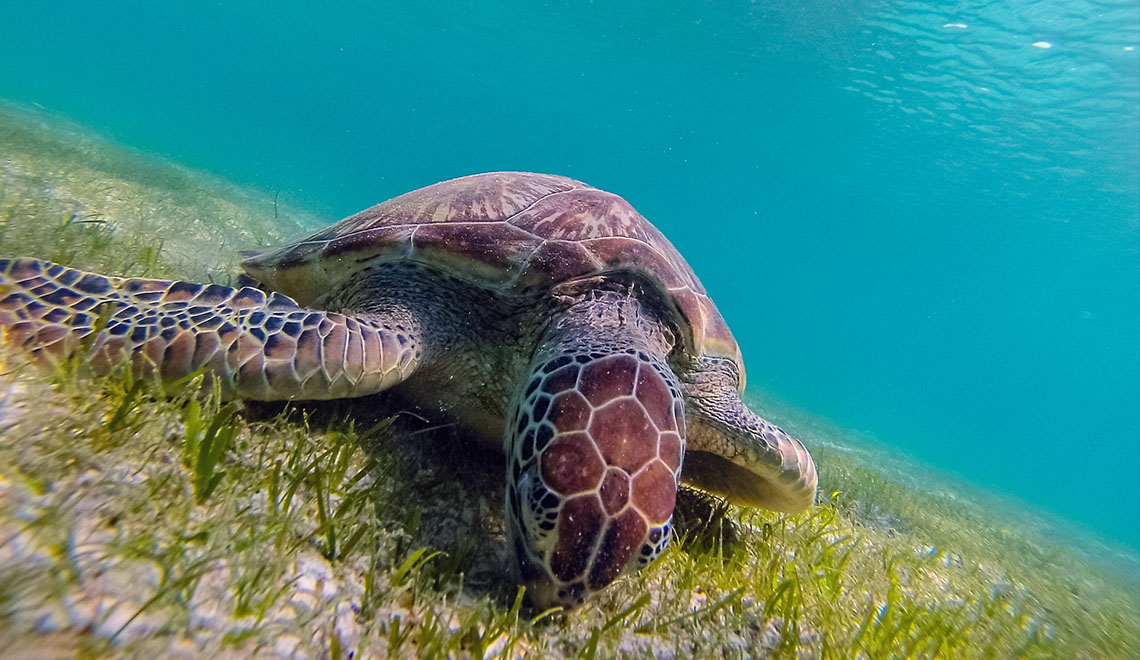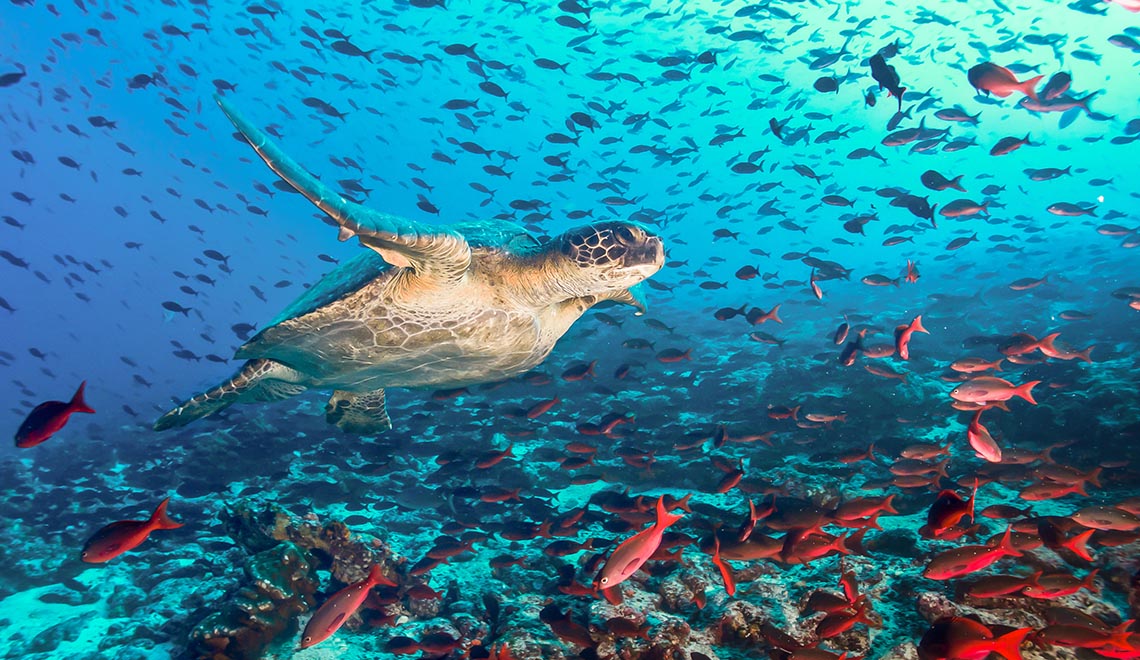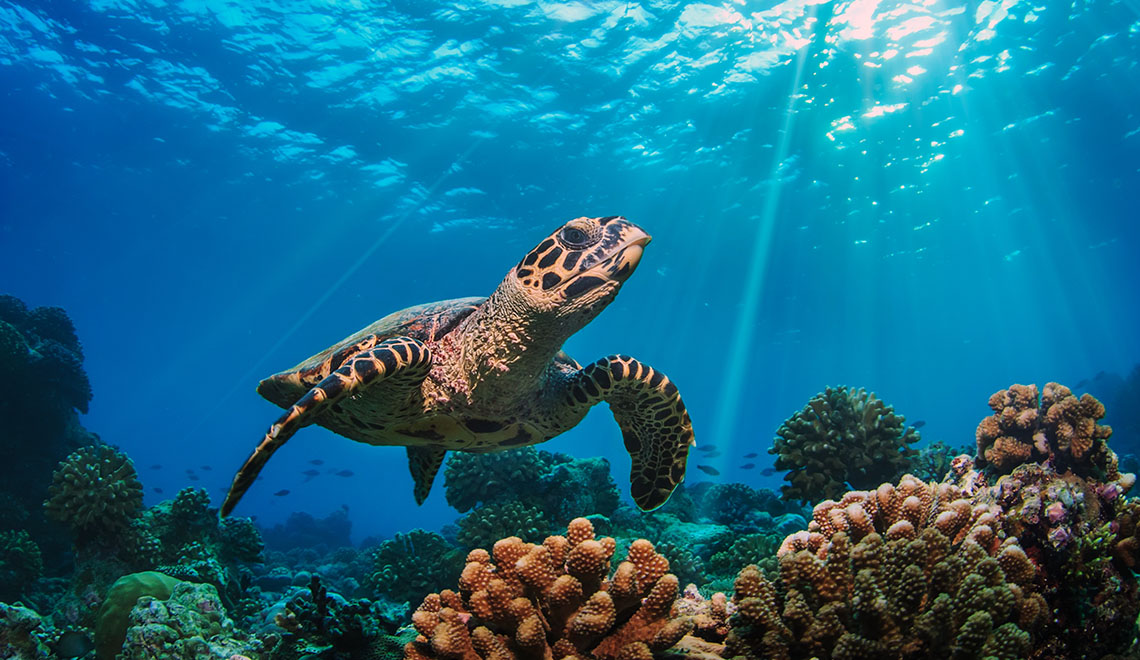The top 5 places to dive with sea turtles
Sea turtles are incredible and mysterious animals. They can outlive humans; they don’t reach sexual maturity until age 35 and can mate for 48 hours. Plus, no one knows where they disappear for an entire chunk of their life, known as the ‘lost years.’ There are seven species of sea turtles (you can tell each species apart from their jaw structure and shell shape).
Most sea turtles can be found in tropical and subtropical waters, and sea turtles are known to migrate thousands of kilometers across the ocean to breed and feed. Swimming with these ancient reptiles is one of the most sought-after and treasured dive experiences, and it’s easy to see why. Their friendly demeanor, adorable facial expressions, and pure grace in the water are hard to tire of. Luckily, there are plenty of wonderful places to encounter sea turtles worldwide.
The Great Barrier Reef, Australia

6 of the 7 sea turtle species can be spotted in the waters of the Great Barrier Reef. Thousands of kilometers long, the Reef provides sanctuary for sea turtles that come to forage, breed, and nest along it. Sea turtles are plentiful in the outer parts of the Great Barrier Reef, such as the Ribbon Reefs and Osprey Reefs. The species you’ll most likely spot in the Great Barrier Reef are the green, hawksbill, and loggerhead turtles. Olive Ridleys and leatherbacks have been recorded in the Great Barrier Reef, but sightings aren’t as common. Diving with sea turtles in the Great Barrier Reef, particularly in Osprey Reefs and Ribbon Reefs, is a dream for any diver. These remote and pristine sections of the reef offer an unparalleled opportunity to observe and study the behavior and ecology of these remarkable creatures in their habitat.
The symbiotic relationship between sea turtles and the coral ecosystems here is a marvel to witness, as they play a vital role in maintaining the health of the reefs by controlling sponge populations and promoting coral growth through their feeding habits. These dives provide invaluable insights into the intricate web of life in one of the world's most iconic marine ecosystems, underscoring the urgent need for conservation efforts to protect the sea turtles and the magnificent Great Barrier Reef. Liveaboards in the Great Barrier Reef visit dive sites along the Ribbon Reefs and Osprey Reef, so your chances of bumping into plenty of sea turtles underwater are high.
The Maldives

What can’t you see in the Maldives? Mantas, whale sharks, schools of hammerheads, and plenty of sea turtles make the Maldives one of the most magical dive destinations. These magnificent creatures, especially the green and hawksbill turtles, are emblematic of the region's rich biodiversity. Studying their behavior, habitat choices and interactions with the coral reefs is a true privilege. Observing them feeding on seagrasses or sponges and witnessing their delicate balance within the ecosystem reinforces the importance of conservation efforts in this pristine marine environment.
Every encounter with these ancient reptiles underscores the urgent need to protect their habitats and ensure the survival of these beautiful species for future generations to appreciate and study. South Male Atoll and North Male Atoll are great spots to dive with sea turtles, but you’re likely to see sea turtles on most dives you go on in the Maldives.
Cocos and Galapagos Islands

Diving with sea turtles in the Galapagos is a transformative experience. The Galapagos are a living testament to Charles Darwin's theory of evolution, and the sea turtles that thrive in these unique waters are emblematic of this unparalleled biodiversity. Green sea turtles are the only species of sea turtle to nest in the Galapagos Islands, and the Galapagos green turtle has a slightly darker and more domed shell than the green sea turtle. Hawksbill and green turtles can often be spotted when diving in the waters of the Cocos Islands.
Both Cocos Islands in Costa Rica and the Galapagos Islands in Ecuador are dive meccas of marine megafauna and are similar in the fact the diving conditions can be a little harsher, but the marine life is magnificent. The conditions in these areas can be a little tougher than in warmer parts of the world, so most liveaboards require divers to have completed a minimum number of logged dives before booking. However, the cooler temperatures and tougher conditions are worth it, as you will have some of the most incredible dive experiences possible in the Cocos or Galapagos.
Fiji

Fiji, the soft coral capital of the world, is renowned for its stunning and colorful coral reefs. Fiji's warm, tropical waters are home to an array of sea turtle species, including the hawksbill and the green turtle. Sea turtles are commonly seen throughout Fiji’s numerous islands, including at the coral bommies of Makongi Island and the sheer walls of Wakaya Pass. You can spot plenty of sea turtles there and numerous mantas, reef sharks, and schooling pelagic fish.
Observing their feeding habits, interactions with other marine life, and their choice of nesting sites provides valuable insights into their behavior and ecology. Fiji's commitment to marine conservation through protected areas and sustainable tourism practices ensures that these encounters can continue to inspire and educate, revealing the beauty of sea turtles and emphasizing the importance of preserving their habitats for future generations.
Sea turtles face an uncertain future
Unfortunately, the much-loved sea turtle faces many threats. All seven species of sea turtles are threatened, and populations face problems caused by over-fishing, plastic pollution, climate change, and human development. Many species of sea turtles love to snack on jellyfish, which look very similar to plastic bags. As divers, we can change our daily lives to conserve turtles by reducing our plastic use and sourcing sustainable seafood.










